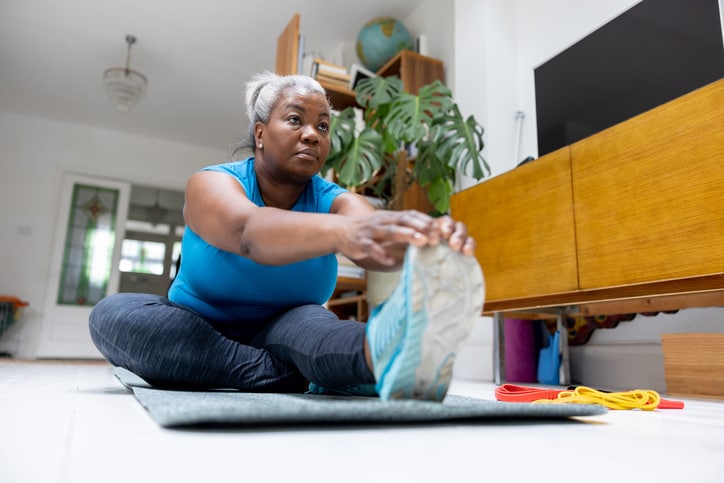By Mary Brophy Marcus
Preparing a home so that it’s wheelchair accessible can be incredibly stressful. Usually, when you need to move a relative into your home or adapt their home to their new life in a wheelchair, your family is already going through a medical crisis. “It puts a lot of pressure on caregivers and their families,” says Maria Torroella Carney, MD, chief of the Division of Geriatric and Palliative Medicine at Northwell Health in New Hyde Park, New York.
Consider these changes, some small and some more involved, that can help you make your home wheelchair-ready. And those who take care of older relatives can learn from their experiences. “Start thinking, even in middle age, about making your home livable for the next 20 years of your life,” says Carney.
General changes
Experts refer to homes that are wheelchair-friendly as “accessible homes.” Any contractor may be qualified to make these changes, but some contractors are more experienced with projects that support aging in place. The National Association of Home Builders (NAHB) has a network of builders with aging-in-place training, also known as CAPS (Certified Aging-in-Place Specialist) designation.
Doorways
According to the Americans with Disabilities Act (ADA), accessible doors should be at least 32 inches wide. This dimension measures from the face of the door panel when open at 90 degrees to the opposing door stop, rather than the door panel size.
“If your doorways are only an inch or so narrower [than 32 inches], a contractor or home repair company can install ‘swing-away’ hinges to swing the door out of the clear opening. If you need a more significant expansion, a contractor can also widen doorways to accommodate the clear width,” explains Seattle architect Karen Braitmayer, who specializes in universal design and accessibility.
Doorways and thresholds also shouldn’t have “lips” or steps that a person’s chair could trip up on, Carney notes.
Door hardware
Door hardware should be operable with one hand and not require tight grasping or twisting of the wrist. Traditional round doorknobs do not meet those standards, but lever hardware or “D” loop handles are good options, says Braitmayer.
Ramps
Ramps should be installed at entrances to the home, but make sure they’re done according to local building codes. “Be sure the slope is in a safe range,” says Braitmayer. “Typically a ramp will have a rise of less than 1 inch to every 12 inches of run. This means a safe ramp is longer than a set of stairs.”
If the entry to the home has no more than two steps, a sloped walkway can often be added to the landscape, so the new ramp won’t need to be a major change to the entry facade. If the entry to a home has more than two steps, either a long ramp or a platform lift can be considered. “Sometimes the easiest entry to ramp is through the garage or back door, if the number of steps is fewer,” Braitmayer says.
If the home has more than one level, an elevator can be considered, but most people find this a very costly alteration, Braitmayer adds. Usually it’s easier to move the bedroom of the person in the wheelchair to the main floor.
Space considerations
All rooms, including the bathroom, should accommodate a wheelchair and, ideally, allow for it to turn around in the space so that getting in and out is easier. “Best practice is to have a space that is 60 inches in diameter clear in a room,” says Braitmayer. “Minimum usability is a space that is 30 inches by 48 inches, the footprint of a standard adult wheelchair.”
Bathroom
The most accessible option would be a walk-in shower without any lip to step over, as well as a handheld shower head mounted on a slide bar and a fixed seat so that a person can sit while they bathe. Pedestal sinks are also easier for wheelchair users than cabinet-style sinks because a wheelchair can slide under them, making brushing teeth and grooming easier.
But if a major bathroom remodel isn’t in the budget, at least add a portable shower bench. Some shower seats come with backs and armrests, which can help the user feel more supported, or help them stand up, Braitmayer notes.
Grab bars in the shower are safety features that benefit everyone. Towel racks can double as handrails, too. These should be installed by a contractor who can ensure that they are properly supported, with backing that will withstand significant applied force. “Anything that is intended to be a grab bar should have a professional installation,” says Braitmayer.
Other features to consider:
- Mount a low mirror for grooming tasks.
- Make sure there is storage space within reach.
- Skip throw rugs, which can catch on wheelchair wheels.
Kitchen
While a frail older person may not be preparing food daily, they may want to microwave a meal or access dishes and glasses. Easy fixes include setting the microwave at counter level and making sure anything the wheelchair user might need is in an easy-to-reach cabinet.
If you’re making larger-scale changes, experts recommend expanding pathways around a kitchen island to be at least 48 inches wide for easy access. As in the bathroom, a sink with knee and toe space is another feature that can make kitchen use easier.
Flooring and lighting
Avoid area rugs, which can impede wheelchair movement as well as pose a tripping risk. “All hard surface flooring is better than area rugs or deeply padded carpets,” Braitmayer notes.
Be sure there’s plenty of lighting in rooms, hallways, and on the exterior of the house. Moving electrical outlets higher up can make life easier, too, but will likely require an electrician. Add remote devices to turn lamps and other electronics on and off. If you do this, the remote can stay near a favorite sitting place or bedside, says Braitmayer—no rewiring required.
For safety’s sake, always be sure that a telephone is within easy reach of the person’s bed or chair, too, says Carney.
If you can afford it, smart home technology can help a lot, too—for example, enabling you to activate lights from your mobile phone as you’re rolling a wheelchair up a dark front entrance ramp.
Paying for home modifications
Renovating can be costly, says Braitmayer. “We look at a barrier removal strategy first, hoping to figure out the most effective changes first, such as getting in the home, doorways, and getting to the toilet. Then we look at the details. Sometimes, just knowing the right tools to assist can make a difference that doesn’t require architectural changes,” she says.
The NAHB website can help you find a Certified Aging-in-Place Specialist; these builders and architects can help you determine costs, says Braitmayer. Note that Medicare and most private insurance does not pay for home modifications. Medicare may pay for assistive technology devices related to medical needs in some cases, or for an occupational therapist to evaluate your home and recommend changes.
Medicaid may offer financial assistance to some low-income, qualified seniors to modify their homes, but coverage varies by state. In Medicaid-speak, home modifications may be referred to as “Environmental Accessibility Adaptations.”
The U.S. Department of Veterans Affairs also provides grants to service members and veterans with certain permanent and total service-connected disabilities to help them purchase or construct an adapted home, or to modify an existing home to accommodate a disability. Two grant programs include the Specially Adapted Housing (SAH) grant and the Special Housing Adaptation (SHA) grant.
Other options that may help with the costs of making a home more accessible include loans and volunteer labor groups, including Habitat for Humanity. Call your local Habitat chapter to inquire about local services, such as help installing grab bars and wheelchair ramps.



